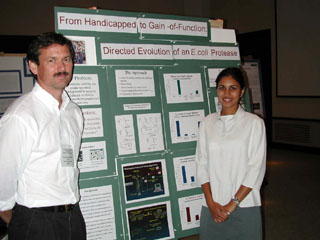What's New?
The 1999-2000 Beckman Scholars: Shanti Nulu, MD
| Faculty Mentor: Professor Brent L. Iverson Length of term: Summer 99, Fall 99, Spring 00, Summer 00. Honors & Awards: University Honors (Spring 99, Fall 99, Spr 01); Mahatma Gandhi Scholarship (Spring 00); Steiner Pre-med scholarship (Fall 99, Spring 00) Where is she now? Graduated with Bachelor of Arts in Asian Studies with High Honors, and Special Honors in Asian Studies May 2001. Shanti was in the MD/PhD program at Baylor U, was a medical resident at U Washington, and is now a doctor of internal medicine in New York. |
 |
Beckman research project in the Iverson group:
Enzyme evolution using fluorescence-activated cell sorting
My research concerns the development of techniques to artificially evolve enzymes using Fluorescence-Activated Cell Sorting (FACS) technology. More specifically, my project was the directed evolution of a gain-of-function enzyme through the exploitation of reversible catalytically-deficient mutants.
Fluorescence-activated cell sorting (FACS) is a relatively new method for quickly screening protein libraries. Recently, a method for screening protein libraries on the basis of affinity using FACS technology was developed by my research group. Using this method, a cell surface displayed library (CSDL) is used, where the displayed proteins are first incubated with fluorescently-tagged antigen in solution. The FACS instrument is able to collect the high-affinity protein members of the library, which have a greater fluorescence intensity, separately from the low-affinity ones.
Directed evolution is a system of randomly mutagenizing a protein to create a library, followed by selection of mutants with novel properties. In the case of enzymes, catalytic activity and substrate affinity can both be used as selection criteria. The aim of this project was to resolve a problem encountered during the selection phase of directed evolution using FACS – that high enzyme activity can create too much background in FACS selection, making the selection of a gain-of-function mutant difficult. Thus, we have attempted to reduce the background in the FACS screen by using a reversible catalytically-deficient mutant as the basis for evolution, so that the difference in activity between the original enzyme and the newly evolved gain-of-function enzyme is magnified. The overall method was as follows:
- Create a catalytically-deficient mutant using site-directed mutagenesis (such as Overlap PCR or Unique-Site Elimination) to mutate a known active-site residue.
- Create a library from this catalytically-deficient enzyme, using error-prone PCR.
- Screen using FACS with a substrate for native enzyme that is compatible for FACS.
- Revert original active-site mutation using site-directed mutagenesis. This should restore kcat to normal/functional levels.
- Characterize the final mutant for a gain-of-function and overall activity levels.
OmpT, a protease associated with the outer membrane of E. coli, was used for directed evolution using the method outlined above. The catalytically-deficient mutant displayed low-levels of activity, as expected. The library-selected mutant, named 3E12, also displayed low activity levels, with a kcat/Km (enzyme efficiency) that was 0.01% of the native value. However, 3E12 also showed a ten-fold decrease in Km, which can be thought of as a ten-fold increase in affinity. The reverted final mutant, named SN12, was found to have functional activity levels, with an enzymatic efficiency (kcat/Km) that was increased to roughly half of native enzyme. Its Km was 33% of that of native OmpT, thus displaying a gain-of-function, a greater substrate affinity.
This project has shown that reversible catalytically-impaired mutants can resolve the problem of high-background FACS selection of enzyme libraries, and that reversible catalytically-impaired mutants can be exploited to find a gain-of-function mutant. In order for this project to be complete, one more set of kinetic measurements must be taken. A coumarin substrate was used in a second round of selection after the FACS screening. In addition to the peptide kinetics already completed, kinetics on this coumarin substrate will be taken and compared to the peptide kinetics. After these final measurements are taken, these results will be written up for publication in a journal such as Protein Engineering.

Created and maintained by Ruth Shear. Comments to author at DrRuth@mail.utexas.edu
Created Mon Mar 22nd 1999. Last modified Mon, Mar 16, 2015.